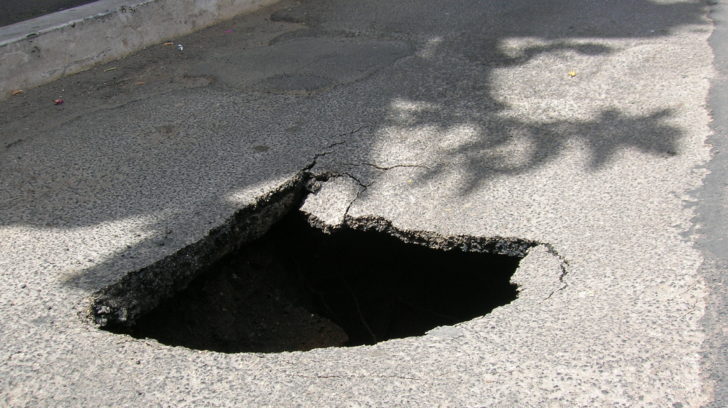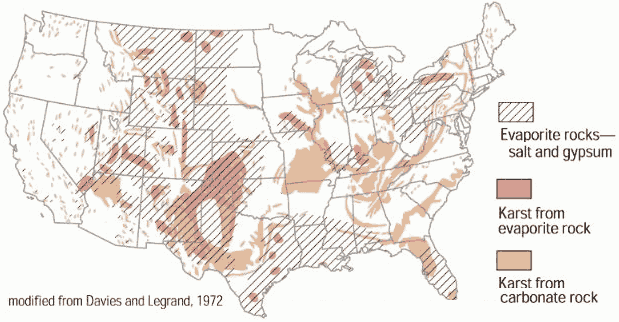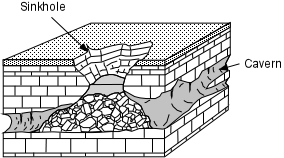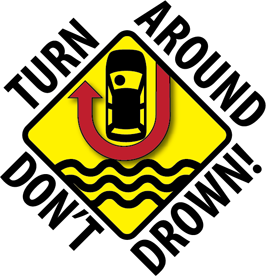Sinkholes; A Whole Lot of Danger
Special Stories
26 Feb 2018 7:54 PM
With the ongoing flooding occurring from the Great Lakes to the Gulf Coast and more to come, it’s a good time to review why not to drive through flooded areas. You see there is an underlying danger in parts of the country that is often lurking just below flood water that can swallow a car whole. Sinkholes are that hidden danger and can often form under pavement or concealed by water.
 Sinkholes are most common in what is called “karst terrain.” These are locations where rock below the surface can be dissolved by groundwater. These soluble rocks can include salt beds, limestone, gypsum and other forms of carbonate rock.
Sinkholes are most common in what is called “karst terrain.” These are locations where rock below the surface can be dissolved by groundwater. These soluble rocks can include salt beds, limestone, gypsum and other forms of carbonate rock.
 Take for instance areas that are underlain by limestone, a type of rock that is slowly dissolved by weak natural acids found in rain and in the pore spaces in soil. Dissolving the limestone creates underground caverns below the surface of the earth. Over the limestone many times we find a fairly thick layer of clay mixed with sand which can remain intact and suspended above the void caused by the erosion. One type of sinkhole that can occur is called a cover collapse sinkhole. Basically the material above the eroding limestone has enough cohesion to hold its shape for a while, but the problem comes when this material loses that cohesion and collapses.
Take for instance areas that are underlain by limestone, a type of rock that is slowly dissolved by weak natural acids found in rain and in the pore spaces in soil. Dissolving the limestone creates underground caverns below the surface of the earth. Over the limestone many times we find a fairly thick layer of clay mixed with sand which can remain intact and suspended above the void caused by the erosion. One type of sinkhole that can occur is called a cover collapse sinkhole. Basically the material above the eroding limestone has enough cohesion to hold its shape for a while, but the problem comes when this material loses that cohesion and collapses.
 Sinkholes can form because of extreme rainfall and because of prolonged drought. Our recent heavy rain added a large amount of rain and weight to the surface material and from that we can see sinkholes. In many cases the underground caverns have a thin ceiling but when the weight gets to be too much that ceiling ceiling can fail and the cavern fills in from material above.
Sinkholes can form because of extreme rainfall and because of prolonged drought. Our recent heavy rain added a large amount of rain and weight to the surface material and from that we can see sinkholes. In many cases the underground caverns have a thin ceiling but when the weight gets to be too much that ceiling ceiling can fail and the cavern fills in from material above.
 Sinkholes can also form during and after times of drought. During droughts underground caverns that might normally be filled with water may be only partially filled. These cavities are less likely to bear the weight of the material above especially when weighted with flood waters or vehicles without collapsing.
When flood water covers the road, a sinkhole or the start of one, may not be visible and bad things can happen to drivers who don’t heed the warning Turn Around, Don’t Drown.
Sinkholes can also form during and after times of drought. During droughts underground caverns that might normally be filled with water may be only partially filled. These cavities are less likely to bear the weight of the material above especially when weighted with flood waters or vehicles without collapsing.
When flood water covers the road, a sinkhole or the start of one, may not be visible and bad things can happen to drivers who don’t heed the warning Turn Around, Don’t Drown.
 If you live in an area prone to sinkholes and water covers a section of road in your path it may be best to find another route.
Meteorologist Mike Morrison
If you live in an area prone to sinkholes and water covers a section of road in your path it may be best to find another route.
Meteorologist Mike Morrison
 Sinkholes are most common in what is called “karst terrain.” These are locations where rock below the surface can be dissolved by groundwater. These soluble rocks can include salt beds, limestone, gypsum and other forms of carbonate rock.
Sinkholes are most common in what is called “karst terrain.” These are locations where rock below the surface can be dissolved by groundwater. These soluble rocks can include salt beds, limestone, gypsum and other forms of carbonate rock.
 Take for instance areas that are underlain by limestone, a type of rock that is slowly dissolved by weak natural acids found in rain and in the pore spaces in soil. Dissolving the limestone creates underground caverns below the surface of the earth. Over the limestone many times we find a fairly thick layer of clay mixed with sand which can remain intact and suspended above the void caused by the erosion. One type of sinkhole that can occur is called a cover collapse sinkhole. Basically the material above the eroding limestone has enough cohesion to hold its shape for a while, but the problem comes when this material loses that cohesion and collapses.
Take for instance areas that are underlain by limestone, a type of rock that is slowly dissolved by weak natural acids found in rain and in the pore spaces in soil. Dissolving the limestone creates underground caverns below the surface of the earth. Over the limestone many times we find a fairly thick layer of clay mixed with sand which can remain intact and suspended above the void caused by the erosion. One type of sinkhole that can occur is called a cover collapse sinkhole. Basically the material above the eroding limestone has enough cohesion to hold its shape for a while, but the problem comes when this material loses that cohesion and collapses.
 Sinkholes can form because of extreme rainfall and because of prolonged drought. Our recent heavy rain added a large amount of rain and weight to the surface material and from that we can see sinkholes. In many cases the underground caverns have a thin ceiling but when the weight gets to be too much that ceiling ceiling can fail and the cavern fills in from material above.
Sinkholes can form because of extreme rainfall and because of prolonged drought. Our recent heavy rain added a large amount of rain and weight to the surface material and from that we can see sinkholes. In many cases the underground caverns have a thin ceiling but when the weight gets to be too much that ceiling ceiling can fail and the cavern fills in from material above.
 Sinkholes can also form during and after times of drought. During droughts underground caverns that might normally be filled with water may be only partially filled. These cavities are less likely to bear the weight of the material above especially when weighted with flood waters or vehicles without collapsing.
When flood water covers the road, a sinkhole or the start of one, may not be visible and bad things can happen to drivers who don’t heed the warning Turn Around, Don’t Drown.
Sinkholes can also form during and after times of drought. During droughts underground caverns that might normally be filled with water may be only partially filled. These cavities are less likely to bear the weight of the material above especially when weighted with flood waters or vehicles without collapsing.
When flood water covers the road, a sinkhole or the start of one, may not be visible and bad things can happen to drivers who don’t heed the warning Turn Around, Don’t Drown.
 If you live in an area prone to sinkholes and water covers a section of road in your path it may be best to find another route.
Meteorologist Mike Morrison
If you live in an area prone to sinkholes and water covers a section of road in your path it may be best to find another route.
Meteorologist Mike MorrisonAll Weather News
More